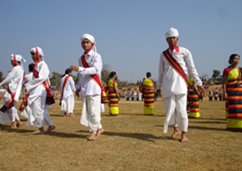

Context
A forum of ethnic communities excluding the Dimasa, the largest, has iterated its demand for carving a separate autonomous district out of the erstwhile North Cachar Hills district of Assam.
Background:
- The North Cachar Hills District Council in Assam was set up on April 29, 1952, under Article 244(2) of the Sixth Schedule to the Constitution of India.
- It was later recognised as an autonomous council.
- The demand was first raised after the North Cachar Hills districtwas renamed Dima Hasao on March 30, 2010, to allegedly stamp the authority of the Dimasa people.
- The resentment among the other communities intensified after the North Cachar Hills Autonomous District Council passed a resolution to rename itself the Dima Hasao Autonomous Council with effect from April 26, 2022.
|
There are 13 tribes constitute about 71% of the district’s total population in the district.
|
Need of a separate forum:
|
The Dima Hasao district currently has one Assembly seat. |
- The Indigenous People’s Forum representing the condition of non-Dimasa communities justified its demand for a separate autonomous district.
- The forum has also been demanding a separate Assembly constituencyfor the indigenous groups.
About
About the Dimasa Community:
- The Dimasa society is tradition bound and guided by customs.
- Important feature: existence of male and female clan. The male clan is called Sengphongand the female clan is known as Jadi
- There are forty male clanand forty-two female clan.
- Whether in marriage, religious practices, or in rituals connected with the death, the clans have a significant role to play.
- Affiliation to one’s own respective clan is quite strong among the Dimasa.

What is the Sixth Schedule?
- According to Article 244 of the Indian Constitution, the Sixth Schedule consists of provisions for the administration of tribal areas in-
- Assam
- Meghalaya
- Tripura
- Mizoram
- Passed by the Constituent Assembly in 1949, it seeks to safeguard the rights of tribal population through the formation of Autonomous District Councils (ADC).
- ADCs are bodies representing a district to which the Constitution has given varying degrees of autonomy within the state legislature.
Autonomous districts and regional councils:
- Along with ADCs, the Sixth Schedule also provides for separate Regional Councils for each area constituted as an autonomous region.
- In all, there are 10 areas in the Northeast that are registered as autonomous districts –
- three in Assam, Meghalaya and Mizoram
- one in Tripura
- These regions are named as district council of (name of district) and regional council of (name of region).
- Each autonomous district and regional council consists of not more than 30 members, of which four are nominated by the governor and the rest via elections. All of them remain in power for a term of five years.
The current governing structure:
- Fifth Schedule: The Frontier State bordering Bhutan, China and Myanmar is under the Fifth Schedulethat “does not provide special rights for the indigenous communities” unlike the Sixth Schedule.
- Sixth Schedule: The Sixth Schedule currently includes 10 autonomous district councils in four north-eastern States — Assam, Meghalaya, Mizoram and Tripura.
- Article 371 (A): Nagaland, on the other hand, is governed by Article 371 (A), which says that no Act of Parliament shall apply in the State in several areas unless the Nagaland Assembly so decides by a resolution.
- These include administration of civil and criminal justice involving decisions according to Naga customary law and ownership and transfer of land and its resources.

